Sintra-Portugal.com
The best independent guide to Sintra
Sintra-Portugal.com
The best independent guide to Sintra
Sintra, Portugal: an independent tourism guide for 2025
Sintra is a charming Portuguese town situated within the cooling hills of the Serra de Sintra. Once a summer retreat for Portuguese nobility and royalty, this UNESCO World Heritage Site delights visitors with its wealth of opulent palaces, extravagant villas, and historic sites, all set amidst lush forests and jagged hills.
These world-class tourist sights include the whimsical Palácio da Pena, the ruins of the Moorish castle, the mystical gardens of the Quinta da Regaleira, and the Arabian-inspired Palácio de Monserrate. Venturing beyond the well-trodden tourist routes, reveals an alternative side of Sintra, one with dense forests, rugged coastlines, secluded religious sites, and wondrous viewpoints, all awaiting exploration by intrepid travellers.
This variety of fascinating sights, abundance of Portuguese charm and stunning natural scenery, make Sintra an outstanding tourist destination, which is regarded as the best day trip of the Lisbon region. A visit to this wonderful town is often a highlight of a trip to Portugal, and it will make a fantastic addition to your holiday plans.
This article will show you why you must visit Sintra and how to get the most from your trip here.
What are the highlights of Sintra?
The Palácio Nacional da Pena
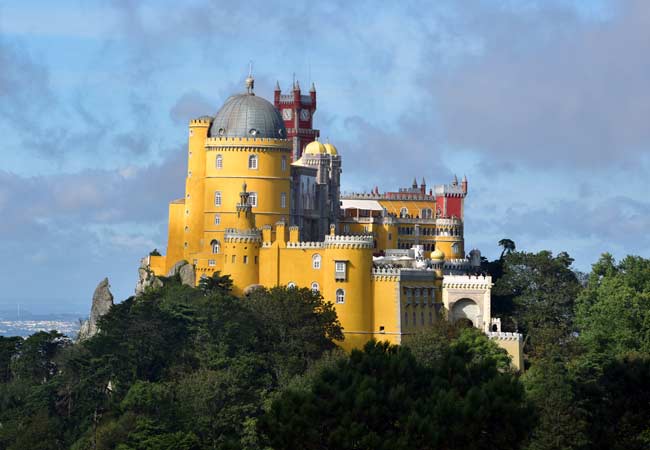
A stunning expression of 19th-century Romanticism, this fantastical palace erupts in a riot of colour from its hilltop perch. Its whimsical design, a vision of King Ferdinand II, blends Gothic towers with Moorish arches and Manueline details, while its terraces afford breathtaking views over the surrounding region. Inside, the state rooms have been meticulously preserved to appear as they did in 1910, during the final days of the Portuguese monarchy - Pena Palace guide
The Quinta da Regaleira
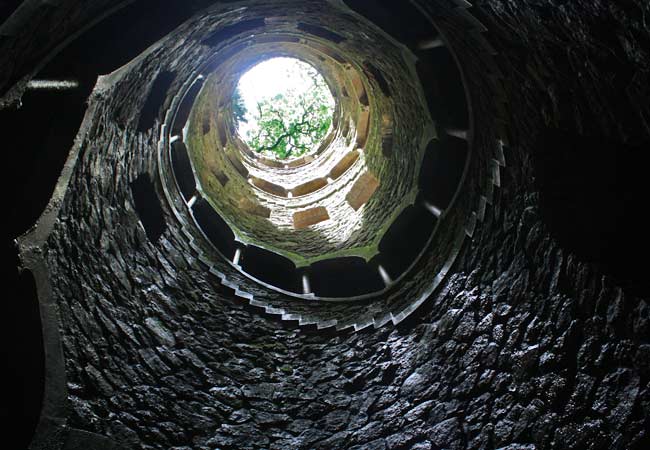
An estate shrouded in mysticism, Quinta da Regaleira is centred on a world of esoteric symbolism. Its enchanting gardens conceal secret passages, grottoes, and the legendary Initiation Well, a subterranean tower that descends deep into the earth. The entire property forms a complex puzzle of alchemical, Masonic, and Knights Templar references. - Quinta da Regaleira guide
The Palácio Nacional de Sintra
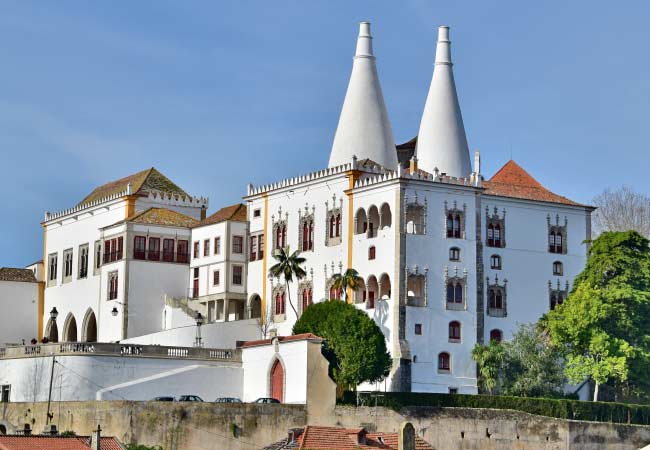
Dominating the historic town with its two immense, white conical chimneys, this is Portugal's best-preserved medieval royal residence. For over five hundred years, it served as the heart of the Portuguese court, providing a clear record of the evolving tastes and histories of the Portuguese monarchy.
The Castelo dos Mouros
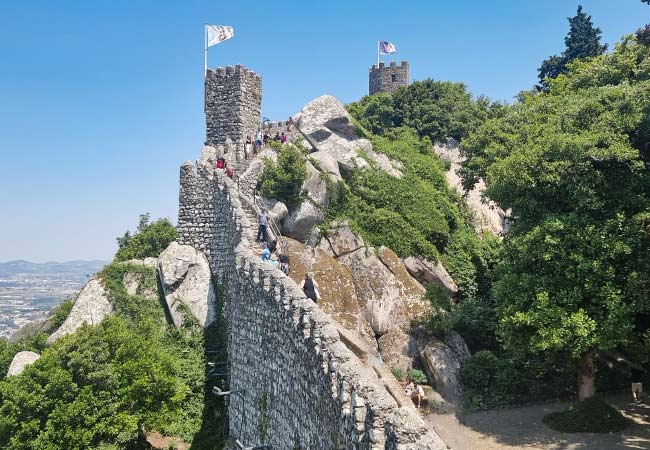
Snaking across a high mountain ridge are the restored ruins of a 9th-century Moorish fortress. Its high battlements and towers give a commanding perspective of the region, demonstrating the strategic importance of this defensive stronghold - Castelo dos Mouros guide
Monserrate Palace
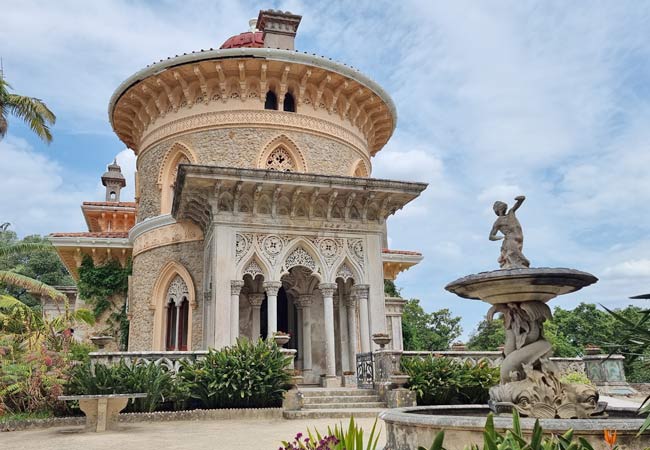
An exquisite jewel of Romantic design, this palace features intricate stonework with a delicate fusion of Gothic, Indian, and Moorish details. It is set within magnificent gardens of exotic plants, all arranged in a series of beautiful, geographically distinct areas. Being outside of the town Monserrate is noticeably less crowded than Sintra's other monuments - Monserrate guide
Exploring the Wider Sintra Region
While the palaces are Sintra's main draw, the surrounding hills and coastline of the Serra de Sintra hold many further treasures.
Hidden deep within the forests is the Convento dos Capuchos, a humble monastery built in harmony with nature. Further west is the Santuário da Peninha, a small chapel perched atop a rock outcrop that provides stunning views over the entire coastline.
Along the region's dramatic coastline, you will find the picturesque village of Azenhas do Mar and the charming beach town of Praia das Maçãs, with its traditional tram that connects to Sintra. At the far western tip of the region is the Cabo da Roca, a headland of towering cliffs and powerful Atlantic waves that marks the most westerly point of mainland Europe.
The Sintra coastline is also home to many magnificent beaches. These include the wild surfing shores of Guincho, the untamed natural beauty of Praia da Ursa, and the stunning, cliff-backed sands of Praia da Adraga.
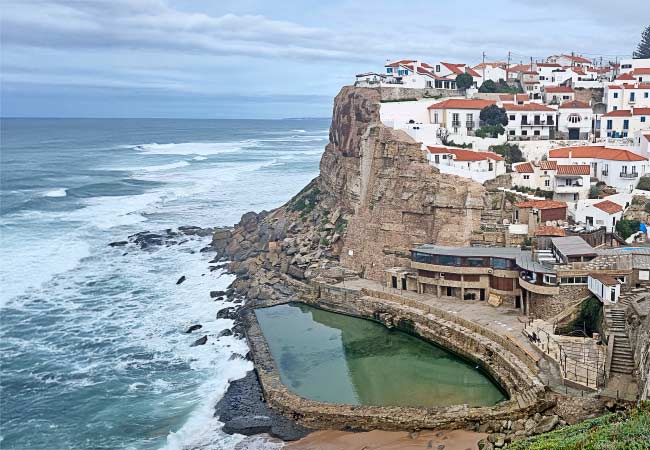
Azenhas do Mar with its natural, ocean-fed swimming pool and distinctive cliff top houses.
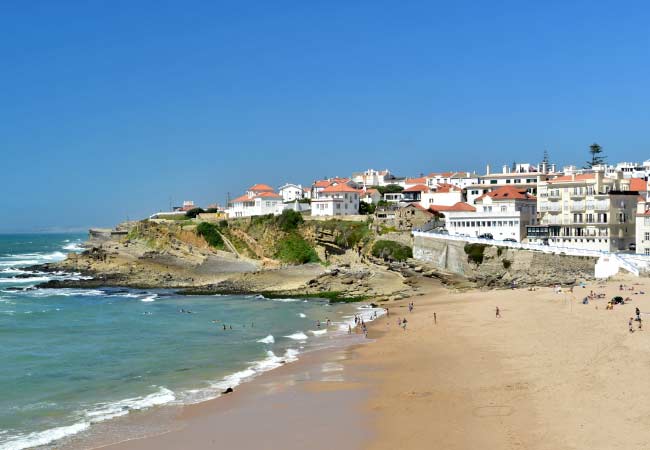
The magnificent sands of Praia das Maçãs are just a scenic, 15-minute tram ride from the centre of Sintra.
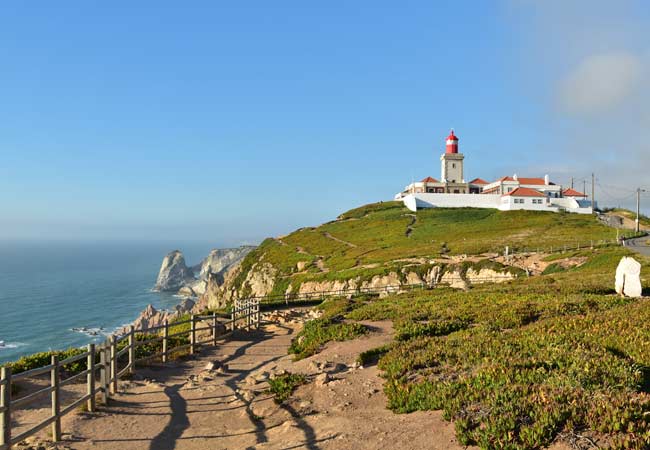
The wind-blasted and rugged cliffs of Cabo da Roca, marking the westernmost point of mainland Europe.
The interactive map below displays the highlights of Sintra and the Sintra region. Note: Zoom out to see the regional markers
Legend: 1) Palácio Nacional da Pena 2) Quinta da Regaleira 3) Palácio Nacional de Sintra 4) Castelo dos Mouros 5) Palácio de Monserrate 6) Palácio Biester 7) Vila Sassetti 8) Convento dos Capuchos 9) Santuário da Peninha 10) Azenhas do Mar 11) Praia das Maçãs 12) Cabo da Roca 13) Praia do Guincho 14) Praia da Ursa 15) Praia da Adraga
Related articles: Sights & attractions in Sintra
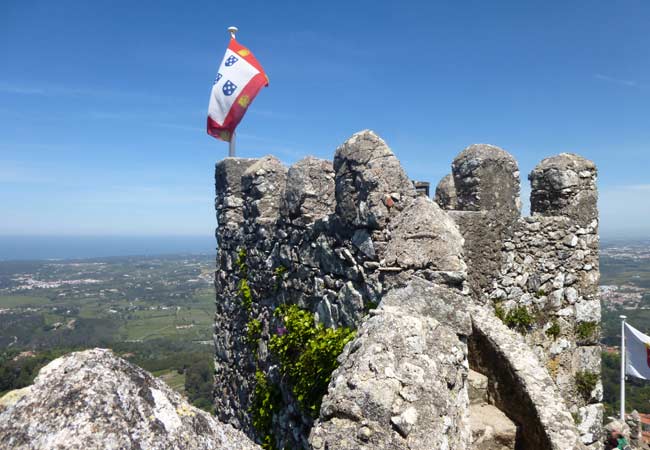
The battlements of the Moorish castle provide spectacular views over the Sintra region
Planning a Day Trip to Sintra
Sintra is one of the most popular day trips from Lisbon and is also easily accessible from the resort towns of Cascais and Estoril. Getting there is straightforward, with a regular train service from Lisbon and direct bus routes from Cascais and Estoril making it a hassle-free excursion suitable for all ages.
A packed but rewarding day trip, designed to cover the main sights, typically follows this route:
• Travel to Sintra via train or bus
• Visit the Palácio Nacional da Pena (the highlight of the day)
• Explore the gardens of the Pena Palace
• Visit the Castelo dos Mouros (optional, depending on time)
• Have lunch in the historic centre
• Explore the charming streets of the historic centre
• Visit the Quinta da Regaleira (or the Palácio Nacional de Sintra)
This popular itinerary is structured around the route of the 434 tourist bus. The bus service conveniently connects the train station with the Palácio da Pena and Castelo dos Mouros at the top of the hill, before returning to the station via the historic town centre, allowing visitors to follow this order logically.
Important - Pena Palace Tickets: Entry to the state rooms of the Pena Palace requires a ticket with a pre-booked time slot. During the peak season, the most popular times sell out well in advance, so it is essential to purchase them before your trip. You can purchase timed tickets from purchased from GetYourGuide here.
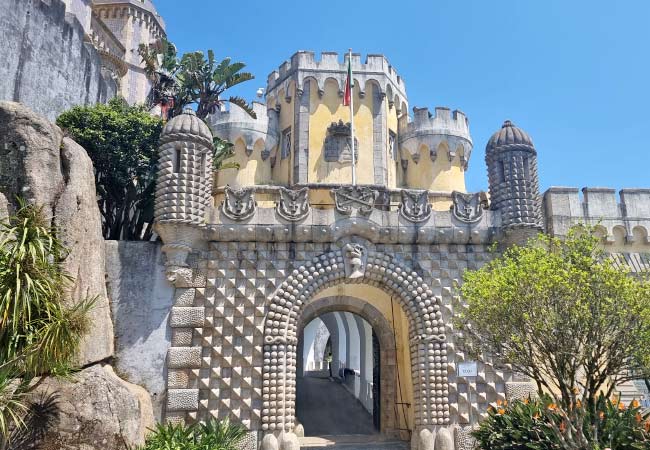
The decorative entrance to the Pena Palace
Navigating the Crowds in Sintra
Sintra's immense popularity, particularly in summer, means it can become extremely crowded. This leads to long queues for entry to the palaces, overcrowded tourist buses, and significant waits for everything from train tickets at Rossio station to a table at lunch.
To successfully manage your day, two strategies are essential: start as early as possible and purchase all tickets online well in advance.
Booking ahead is about more than just skipping the ticket-buying queues. The interior state rooms of the Palácio da Pena and the Quinta da Regaleira both operate on a strict timed-entry system. If you try to buy tickets upon arrival, you will likely find that the next available entry slot is hours away, forcing you into long, unplanned waits that waste precious time. Securing your timed tickets online in advance is the only way to guarantee entry at your desired time and build a logical, efficient itinerary for your day.
The most effective strategy for a day trip is to book your ticket for the Palácio Nacional da Pena early in the day. This allows you to visit before the main tour groups arrive and frees up the middle of the day (from roughly 10:30am to 3pm), when crowds are at their peak. During this time, you could visit the less-busy Castelo dos Mouros or Palácio Nacional de Sintra, or simply wander the expansive grounds of the Pena Park.
For the Quinta da Regaleira, the best strategy is to book your corresponding time slot for later in the afternoon (after 3 pm), as the main crowds begin to depart. Due to its proximity to the historic centre and slightly later opening time, the Quinta da Regaleira is extremely busy in the mornings, creating a massive bottleneck, even for visitors with timed tickets. An afternoon visit ensures a much smoother entry experience and often means shorter queues for the main attractions, including the famous Initiation Well.
If your preference is to avoid the main crowds altogether, the Palácio de Monserrate and Palácio Biester are exceptional choices. The Palácio de Monserrate offers an exquisite beauty that rivals the Pena Palace, with its delicate fusion of Gothic, Indian, and Moorish details. For those drawn to the atmosphere of Quinta da Regaleira, the Palácio Biester provides a similar sense of Gothic mystery and intrigue, which is no surprise as it was designed by the same architect, Luigi Manini.

The Palácio Biester
Is an Organised Tour the Best Way to See Sintra?
While visiting Sintra independently is possible, the spread-out nature of the attractions across steep hills can make logistics challenging. For many visitors, an organised tour is a stress-free and highly efficient alternative. A good tour handles all the transport, bypasses the need to book separate timed-entry tickets, and removes the hassle of navigating crowded public buses.
Beyond just the convenience, a tour provides access to a knowledgeable local guide. They can offer insights and stories that bring the history of the palaces to life, creating a richer experience than a guidebook alone. Furthermore, an organised tour is the only practical way to combine both Sintra and the coastal town of Cascais into a single day.
We have partnered with GetYourGuide.com for the last seven years, as their platform offers tours with clear itineraries, user reviews, and an easy cancellation policy. Below are some of the best-rated tours that cover the most popular routes:
• From Lisbon: Sintra Highlights Full-Day Tour
• From Lisbon: Sintra, Cabo da Roca and Cascais Full-Day Tour
• From Lisbon: Pena Palace and Regaleira Guided Tour
How to Get to Sintra
Sintra is well-connected by public transport, making it a straightforward day trip from Lisbon, Cascais, and Estoril.
By Train from Lisbon The recommended, easiest, and most popular way to travel from Lisbon to Sintra is by train. There are two inexpensive train services:
• From Rossio Station: This is the best option for most tourists, as the station is centrally located near the Baixa and Chiado districts. The journey takes approximately 40 minutes.
• From Oriente Station: This line is convenient if you are travelling from the airport or the Parque das Nações district. The journey takes approximately 47 minutes.
Both train lines are part of the Lisbon urban network. A return ticket costs €4.90 and is charged to the reusable "Navegante" card. Services are frequent, with multiple departures per hour, running from early in the morning until late at night.
A Warning About Driving to Sintra: We strongly advise against driving to Sintra. The historic centre is characterised by narrow, winding roads completely unsuitable for the volume of modern traffic. Parking is extremely limited, and during peak season, the area becomes gridlocked with constant traffic jams as drivers hunt for non-existent spaces. Taking public transport is a significantly less stressful option.
By Bus from Cascais and Estoril
Direct bus services, operated by Carris Metropolitana, are the best way to travel to Sintra from the coastal resort towns.
• From Cascais, you have two main options departing from the Cascais Terminal:
-Route 1623: This is the direct and faster service, with a journey time of approximately 30 minutes.
-
Route 1624: This is a longer, scenic coastal route that travels via the Cabo da Roca cliffs, taking around 60 minutes.
• From Estoril, the primary service is the scenic Route 1624, which also departs from near the train station.
Important Note: These bus services terminate at Portela de Sintra train station, not in the historic centre. This is a significant 2km walk from the main tourist area. Upon arrival, you will likely need to connect to the 434 tourist bus to reach the Palácio da Pena and other key sights.
Related articles: Lisbon to Sintra – Cascais to Sintra – Estoril to Sintra

The 434 and 435 tourist buses
The 3km walk from the historic centre to the Palácio da Pena is up a very steep hill and is not suitable for most visitors, especially in the heat of summer. The 434 tourist bus provides the only practical way to avoid this challenging walk. The bus service connects the train station to the historic centre, then climbs the hill to the Palácio Nacional da Pena (with a stop for the Castelo dos Mouros) before returning to the train station.
The 24-hour hop-on-hop-off ticket, which covers all Sintra bus routes, costs €13.50. Buses depart from outside the Sintra train station every 15 minutes during the high season.
It is important to be prepared for the journey itself. Expect the bus to be extremely crowded, with standing room only for the surprisingly long 30-minute ride to the top of the hill. The long ride is due to the historic centre of Sintra being closed to traffic, forcing the bus onto a narrow ring road that is often clogged with tourist vehicles. In the peak season, the bus ride can be longer than 40 minutes with significant sections of nauseating stop-go traffic.
As this is the only road to the summit, taking an Uber, Bolt, or Tuk-Tuk will be no faster than the bus. Uber/Bolt drivers will often decline fares from the town or station up to the Pena Palace due to the traffic.
Note on single fares: A single ticket (€4.55) technically exists, but this is often removed from sale at peak times. The mobile sellers and bus drivers will only offer the expensive 24-hour pass. However, it may be possible to buy a single fare from the ticket office opposite the train station.
The 435 tourist bus connects the train station to the Palácio de Monserrate, passing the historic centre, the Quinta da Regaleira, and the Seteais Palace. This bus is ideal for a second day in Sintra.
Related articles: The 434-tourist bus
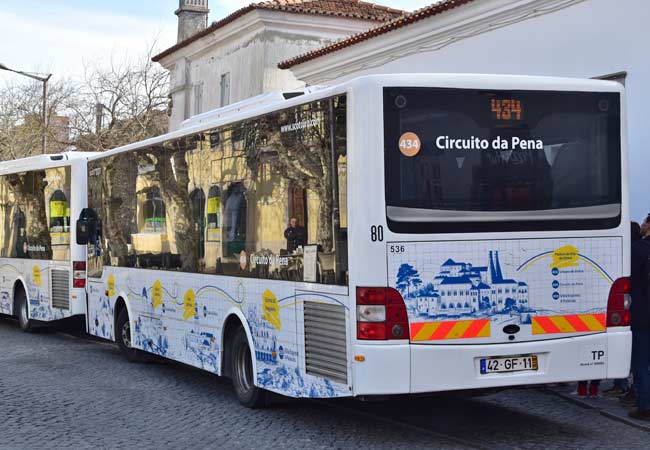
The 435 and 434 buses waiting at the train station
Why spend a night in Sintra?
If you plan to spend two or three days visiting Sintra, it is recommended to stay within the town, instead of travelling in from Lisbon each day. The main advantage of being based in Sintra is that the town can be enjoyed once the day-trippers and coach tours have left.
The key national monuments of Sintra have extending opening hours, allowing you to visit before or after the daytime rush. The town offers a fantastic range of hotels to choose from, with many of these in keeping with the style and charm of the region.
The map below shows the location of hotels and rental rooms in Sintra, and by altering the date to your holiday, the map will display current prices:
Two or three days in Sintra
Sintra is often visited as a day trip from Lisbon, but there are sufficient attractions to easily fill two or three days of sightseeing. Suggested itineraries for two or three days in Sintra, which follow on from the 1-day trip include:
A second day in Sintra
• Quinta da Regaleira and gardens (or the Palácio Nacional de Sintra)
• Palácio de Seteais
• Palácio de Monserrate
• Vila Sassetti and gardens (optional)
• Hike up the Caminho de Vila Sassetti (optional)
Third day in Sintra
• Convento dos Capuchos
• Peninha Sanctuary and viewpoint (highlight)
• Cabo da Roca
• Praia da Ursa or Praia da Adraga
• Chalet da Condessa D'Edla (Pena Park)
• Hike to Cruz Alta (Pena Park)
Note: this day trip requires a car
Related articles: A second day in Sintra – Sintra’s secret sights
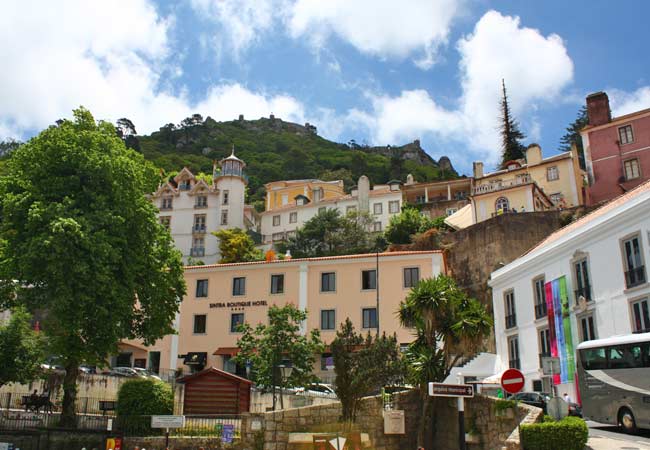
Why are there so many palaces and grand mansions in Sintra?
Historically, the reason was due to the slightly cooler climate that the hills of the Serra de Sintra provide. This enticed the nobility of Portugal to construct their summer residences here. During the 19th century, Sintra was a popular destination for Europe's wealthy artisans and elite, who built elaborate mansions following the Romanticism style of architecture.

The Quinta da Regaleira
Our favourite attractions in Sintra
Our favourite attractions in Sintra are:
1) Palácio Nacional da Pena 2) Quinta da Regaleira 3) Palácio Nacional de Sintra 4) Palácio de Monserrate 5) Castelo dos Mouros 6) Palácio de Seteais 7) Vila Sassetti
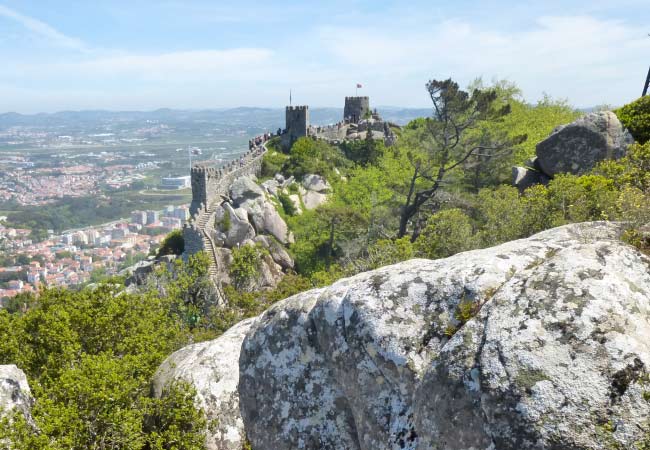
The Castelo dos Mouros is postioned high above the old town of Sintra
The Romanticism style of architecture
The town of Sintra is regarded as one of Europe's finest examples of the whimsical and colourful Romanticist style of architecture. This elaborate, 19th-century design style was inspired by a love of art and the mysticism of ancient cultures, creating decorative and flamboyant buildings, of which the Palácio da Pena is the finest example.
Our most popular guides to Sintra
If you've found our content valuable, we'd welcome your support.
The digital publishing landscape has evolved significantly. As a small independent publisher, we face growing challenges. Search engines increasingly favour paid content over organic results, while AI-generated content often reproduces original work without attribution.
To support our work, please consider bookmarking this page (press Ctrl + D) for quick access. If you find an article helpful, we'd be grateful if you'd share it with friends on social media.
For specific questions, please see our Reddit community at r/LisbonPortugalTravel.
Should you notice any outdated or incorrect information, please contact us at [email protected]
Thank you for helping us continue to provide valuable content in an increasingly challenging digital environment.
A complete list of all of our Sintra and Lisbon guides
If you've found our content valuable, we'd welcome your support.
The digital publishing landscape has evolved significantly. As a small independent publisher, we face growing challenges. Search engines increasingly favour paid content over organic results, while AI-generated content often reproduces original work without attribution.
To support our work, please consider bookmarking this page (press Ctrl + D) for quick access. If you find an article helpful, we'd be grateful if you'd share it with friends on social media.
For specific questions, please see our Reddit community at r/LisbonPortugalTravel.
Should you notice any outdated or incorrect information, please contact us at [email protected]
Thank you for helping us continue to provide valuable content in an increasingly challenging digital environment.





























